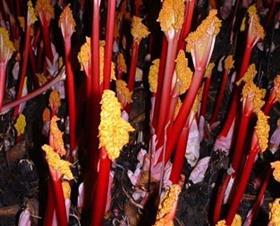
The first Yorkshire forced rhubarb of the season has arrived at a wholesaler in the north west of England, with wholesalers expecting especially strong prices thanks to Brexit.
Bolton-based catering supplier Oliver Kay tweeted on 7 December that it had received its first delivery of the product from a rhubarb triangle supplier, albeit in “really, really small volumes”, bringing forward its supply as restaurants compete to serve the first British rhubarb of the season.
New Covent Garden wholesaler Vernon Mascarenhas said he would normally would not expect to see Yorkshire forced rhubarb on the wholesale market “for another couple of weeks” and he expects demand to be especially high this year due to the weakness of the pound.
“With all this Brexit stuff there’s more emphasis on buying British because of the value of the pound,” he explained. “Whatever people say, one of the effects of Brexit has been that people are focussing more on UK grown produce.”
Current wholesale prices forced rhubarb are evidence of this, Mascarenhas said - the price of forced Dutch rhubarb decreased from £35 to £26 overnight when the first English rhubarb came onto the market. “Now that the first English is out, the Dutch know that everyone’s going to want English over Dutch and have instantly lowered their prices,' he said.
The so-called ‘high priestess of rhubarb’ Janet Oldroyd, who also grows in the Yorkshire triangle, said that her business, E Oldroyd & Sons, will wait until January to begin harvesting rhubarb for Sainsbury’s.
“Anything on the market now wouldn’t have its full quota of cold units,” she explained. “The roots require an amount of frost to convert the energy into glucose and that’s what they grow from. If you don’t wait for the frost, your yields will be a bit lower.”
But she recognised it was in some growers’ interest to pick early and “capture a better price pre-Christmas” on the wholesale market.
Oldroyd added that it is sometimes possible for growers to pick early and get two crops from the same shed, but this can be risky because it leaves you at the mercy of the weather.
“Once the energy’s spent from the roots, you can, if you’re quick, empty the shed of the roots, put fresh ones in and start the whole process again,” she said. “But that’s a bit of a risk because if it’s an early spring, you’re a bit snookered – the price will plummet.”



